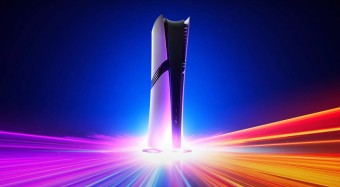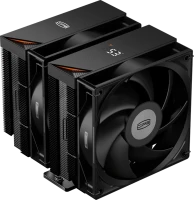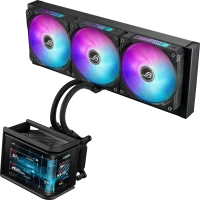Which CPU cooler to choose?
We independently test the products and technologies that we recommend.

The article will cover the basic and additional criteria for selecting air cooling and you can familiarize yourself with the range of box and tower coolers in our catalog.
CPU cooler type
Manufacturers offer different types of coolers, the choice of which depends on the purpose of the computer. Home PCs are rarely subjected to critical loads, so box systems with direct airflow (Top Flow) are suitable here. Their design is quite simple, including a heatsink and fan, which are placed in one plane parallel to the motherboard.

A beneficial advantage of this approach is the associated cooling of components around the processor — VRM, RAM. And the cost of classic coolers is minimal, so manufacturers offer ready-made box kits (BOX) along with the processor. The main disadvantage is low efficiency.
An improved modification of Top Flow coolers is the design with heat pipes.

This type is capable of cooling entry-level and mid-level processors when short-term increased loads are possible. A good example would be an office PC with specialized software or an entry-level gaming PC.
The most efficient air cooling system is a tower cooler. Its design differs from the classic one — contact with the processor is carried out using heat pipes, but the fan is installed perpendicular to the motherboard, so warm air is immediately removed from the case through the rear panel.

There are options with one and two towers, which can be equipped with two or even three fans. Their scope of application relates to the gaming industry, where overclocking and various gaming tricks are practiced.
It should be realized that the efficiency of CPU coolers has limits. In most cases, they are sufficient for normal PC operation, but sometimes it is more rational to immediately pay attention to liquid cooling systems, which are significantly superior in performance to air cooling systems.
TDP indicator
The most important parameter for choosing a cooler is the thermal design power (TDP). There are some details that should be known. Usually, processor manufacturers specify a minimum or average parameter, which increases significantly under prolonged high loads. This is not critical for low-powered PCs, but it can be a fatal mistake for a gaming system.
Choose a cooler with a margin of at least 50% for home PCs and 100% for gaming ones. For example, the stated TDP of 65 W for the Ryzen 5 8600G increases to 125+ W under load and overclocking, so the cooling system must be designed for this. It is also necessary to consider the possibility of clogging of the heat exchanger, dust filters and disruption of air circulation in the system unit, which can lead to deterioration of heat dissipation. The efficiency reserve helps extend the life of the fan and reduce noise levels, since it does not have to constantly operate at maximum speed. In general, for ordinary home and office PCs, a cooler with a TDP of about 100 – 120 W is more than enough. For a gaming CPU it is better to consider options from 150W.
Substrate materials, a way of contact and number of heat pipes
The ability to dissipate heat depends largely on the materials and the way the substrate is in contact with the processor. Aluminium-plated coolers are quite effective and can reduce the cost of the final product. Thermal conductivity of metal is 203.5 W/(m*K), which is enough to cool chips of any level, except for the hottest ones, where it is better to switch to liquid cooling system by default. Copper substrates are less popular, despite the fact that they do their job much better. The thermal conductivity of the material reaches 394 W/(m*K). There is a stereotype that copper will cost much more, but in fact you can easily find an affordable option with a price tag of about 50 $. In recent years, nickel-plated copper substrates have become increasingly popular. It prevents the process of corrosion, oxidation and scratches in case of accidental contact with hard objects during installation and maintenance.
When choosing a CPU cooler, many people recommend taking into account the way of contact, which can be direct or indirect. However, manufacturers have long ago learned to make highly efficient substrates of both types, so it all depends only on the materials and soldering quality, which can not be visually determined. As for the number of heat pipes, there should be at least 3 – 4 of them. In box models they may be absent at all, and the processor transfers heat directly to the heatsink.
If you are assembling a home/office PC based on low-power Core i3 or Ryzen 3 chips, you can safely take any variant of a classic cooler with indirect contact. This is exactly what manufacturers of processors in the boxed versions do most often. For warm Ryzen 5 / Core i5 and higher, you should pay attention to models with at least four pipes and heat dissipation directly through them.
Fan specifications
The quality and characteristics of the fan affect not only the cooling efficiency, but also the using comfort. When choosing a fan, it is necessary to pay attention to the size, the number of revolutions and the noise level, which are usually interrelated. Here it is necessary to remember a simple rule — the smaller the size, the more revolutions are needed for cooling, which means that the noise level will increase and wear occurs faster. For this reason, the 80 mm models have practically disappeared.
The optimal size of the fan is considered to be 120 mm. It provides a good speed-to-noise ratio, allowing you to comfortably perform resource-intensive processes. Quite common are models with 92 mm. Coolers with a 140 mm in size are the quietest, but they are not often used, as heatsinks of such sizes may not fit into the system unit, and not every motherboard can withstand the weight of such a design.
The type of bearing that provides rotation is also important in fans. The simplest and cheapest is the sliding method, but its efficiency is also quite debatable. At constant high speeds, the mechanism wears out quickly, so it is more suitable for low-power computers. The hydrodynamic bearing is the quietest, most efficient and durable, and therefore has gained the greatest popularity in all price categories.
Another nuance regarding fans concerns its connection and control. The connector can be 3 pin or 4 pin. In the first case, only manual speed adjustment via the BIOS is possible, which requires certain knowledge. An additional line at the 4 pin connector ensures automatic rotation adjustment depending on the temperature sensors of the motherboard, so the user does not need to think about settings. Such fans are often called PWM.
Cooler size
Size limits only apply to tower coolers, which simply may not fit into the system unit or block RAM slots. When choosing an air cooler for a processor, it is necessary to take this point into account to ensure compatibility of all components. This is especially true for compact micro-ATX and mini-ITX motherboards. Advanced tower coolers are distinguished by their height, which must be taken into account when subsequently choosing a computer case, where this parameter is limited.
Socket
The fit is a very important parameter, but there is no point in focusing on it today. Most coolers come with several sets of mounts, providing compatibility with all popular sockets from Intel (1150, 1155, 1700, 1200) and AMD (AM4, AM5). Difficulties may arise only with outdated modifications like FM2+ / AM3 / 775, which are still used at home. In general, it is recommended to check what configuration and compatibility is guaranteed by the cooler manufacturer and compare it with the data of the processor or motherboard.
Design
For office and many home PCs, the topic of design is not touched upon, as cases without a viewing window are used there, and the cooling system is more often represented by a box version from the manufacturer. But when developing a design assembly, any detail matters, so manufacturers offer different colors to make the cooler match the overall concept. Here it is up to the user to decide which approach to choose — to do everything in one color or to combine. A win-win option when choosing a cooler is ARGB backlight, which allows you to change the design style and choose from a large number of shades. Manufacturers such as Asus and Gigabyte make systems that support proprietary backlight synchronization technologies. Other brands focus on compatibility with all motherboard technologies, ensuring multi-compatibility of use.
For convenience, our experts have prepared general recommendations for choosing a CPU cooler depending on the purpose of the PC. For the simplest home assemblies based on low-power processors aimed at the browser, movies, music, a box cooler with a TDP of up to 100 W without heat pipes is suitable. This can be either the most budget ID-COOLING DK-01T or Top Flow with PCCooler E126M PRO backlight.
For more active use, performing work tasks at home and in the office, multitasking (a large number of open browser tabs, documents, google sheets), it is better to use coolers with direct contact of heat pipes and a TDP of 100 W or more. A good example is the ID-COOLING IS-50X V3 or Xilence A404T. Such models can easily cope with the increased heat dissipation of Ryzen 3 and Core i3.
For working with graphics and multimedia, implementing design projects with specialized software, performing accounting tasks requires a more powerful PC, and therefore a cooling system. Tower coolers with a TDP of 120 – 150 W will cope best, for example, PCCooler Paladin EX300S.
For gaming PCs, the cooling system is critical, so every little detail matters. A good tower with a large number of copper heat pipes and a high-speed fan on a hydraulic bearing is definitely necessary. In order to avoid trotting and achieve acceptable noise level, you will have to choose the most efficient coolers with TDP 200+W. The be quiet! Dark Rock Elite and Noctua NH-D15 have proven themselves in this area.
Articles, reviews, useful tips
All materials



































































